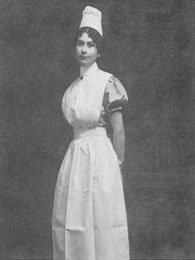|
DR.
JOHN TOLMIE ARRIVED IN HARTNEY with a wife and son and an African grey
parrot called Jack in the late summer of 1906. He had spent the
previous three years at the University of Edinburgh and on the P &
O boats (where he acted as part-time ship’s surgeon), taking his FRCS.
Previous to that he had spent four years at McGill University studying
medicine under the famous Dr. Osler. On returning to Canada from
Edinburgh he married Maude Emma Ross, the daughter of an old Sherbrooke
family whose father was John Ross, one-time mayor of Sherbrooke,
Quebec. With this new bride and the parrot, which he had picked up on
the west coast of Africa on his last voyage with P & O, Dr. Tolmie
came to Hartney and started the practice of medicine. The house that he
bought shows his first two children, Jean and Ross sitting on the front
fence.
Dr. Tolmie was the only doctor in the Hartney district for eleven
years. There was no hospital and at first there were no cars. He
maintained two teams of horses and a cutter for winter calls in the
country and eventually (about 1910 or 19111) he bought the first car in
the district – a brass adorned Ford with acetylene lamps and a very
temperamental crank. That crank had a habit of kicking back and
breaking the arms of the cranker. Dr. Tolmie later mended so many arms
of new owners of cars that he developed a quick half turn of the engine
and hasty withdrawl of hand and arm from the orbit of the backfiring
crank.
The Tolmie family ultimately moved to British Columbia, where he
retired in 1948. After one winter of idleness, sitting in the lobby of
the Vancouver Hotel, he decided to become active again. He saw an
appeal in the Vancouver papers for a volunteer job on the Anglican
mission boat “The Columbia,” where they desperately needed a doctor to
fill in for the previous incumbent who had suffered a nervous
breakdown. Dr. Tolmie volunteered and had one last year of very active
and adventurous medical practice up and down the B.C. coast, delivering
babies, pulling teeth and performing emergency operations on loggers or
miners who had experienced serious accidents. After his final year he
was content to retire. He lived for another 18 years, dying in January
1967, within six months of his 100th birthday.
Adapted from A Century of Living, page 637.
Nursing
in 1900
A nurse like Hartney’s Margaret McKie, who did this and that,
In the early 20th century, most nurses received their education from
hospitals, not colleges or universities. While earning diplomas at
hospital-based schools, student nurses provided the facility with two
to three years of cheap and abundant labor, typically working 10- to
12-hour shifts seven days a week, with only a few hours dedicated to
classroom instruction. Historians describe early clinical training
programs as rigorous and exhausting.
After graduating, a nurse in the early 1900s usually went to work as a
private-duty nurse in a patient’s home or as a superintendent in a
hospital. Many nurses averaged about $5 a week near the turn of the
century—barely enough to live on. Nurses’ care-giving duties included
giving baths, inserting catheters, administering enemas and
medications, dressing wounds and sores, and generally monitoring
patients’ appearance. In the early 1900s, nurses still administered
leeches to treat inflammations or engorgement and relied heavily on
poultices, stupes, and plasters to relieve everything from congestion
to colic.

Nurse A. Dalziel of Hartney.
|





